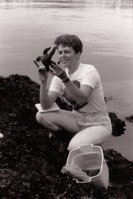Our one and only planet is big, 25,000 miles around, but it has just a tiny little layer of atmosphere. From downtown Salem it’s about the same distance up to outer space as it is sideways to Silverton. Hence, the atmosphere can only take so much human burning. We do a lot of burning. It causes a greenhouse effect and traps heat.
That’s right, it’s us people, almost for sure, according to the Intergovernmental Panel on Climate Change report #4 “Summary for Policy Makers” that was released the other day.
Almost no doubt that people are the cause, so let’s move on to How bad is it? Can we humans prevent major awfulness if we make some changes? This New York Times article, Science Panel Calls Global Warming ‘Unequivocal’ (brought to our attention by Pringle Creek's project architect, Mark Kogut of Opsis; thanks, Mark), provides some analysis of the report's assessment.
[The report] said warming and its harmful consequences could be substantially blunted by prompt action.While the report provided scant new evidence of a climate apocalypse now, and while it expressly avoided recommending courses of action, officials from the United Nations agencies that created the panel in 1988 said it spoke of the urgent need to limit looming and momentous risks.
Whew, sounds like if we can make some big changes, we can keep the planet comfortable. Some details are provided:
The new report says the global climate is likely to warm 3.5 to 8 degrees Fahrenheit if carbon dioxide concentrations in the atmosphere reach twice the levels of 1750, before the Industrial Revolution.Many energy and environment experts see such a doubling, or worse, as a foregone conclusion after 2050 unless there is a prompt and sustained shift away from the 20th-century pattern of unfettered burning of coal and oil, the main sources of carbon dioxide, and an aggressive expansion of nonpolluting sources of energy.
And the report says there is a more than a 1-in-10 chance of much greater warming, a risk that many experts say is far too high to ignore.
Scary, that last sentence. In another article the NYT talked to more experts who believe the IPCC report is too optimistic: Even Before Its Release, World Climate Report Is Criticized as Too Optimistic.
And here, from the ABC News website,
Climate report fails to highlight extent of global warming, Flannery says. That is Tim Flannery, paleontologist and mammalogist and author of the excellent book, The Weather Makers: How Man Is Changing the Climate and What It Means for Life on Earth and here are his alarming words:
But Professor Tim Flannery says the report's findings are conservative and the real impact of global warming will be felt much sooner. "The actual trajectory we've seen in the arctic over the last two years if you follow that, that implies that the arctic ice cap will be gone in the next five to 15 years," he said. "This is an ice cap that's been around for 3 million years."
Finally, to localize the issue of global warming, The Oregonian talked to Washington State Climatologist, Phil Mote, who worked on the IPCC report, for this (also from Mark Kogut) article, Life as we know it gets blame for global warming [no longer available].
The finding [in the IPCC report] is the most definitive to date in declaring that natural climate cycles do not account for the sharp rise in temperatures since the onset of the Industrial Revolution.The claim also has sharp meaning in the Pacific Northwest, which depends heavily on mountain snows and melt-off for its yearlong water supply. Much of that snowpack is now at risk, making this one of the nation's most vulnerable areas to climate change, according to regional scientists contributing to the report.
Although the IPCC's "Summary for Policymakers" does not mention the Northwest, Mote said the implications are clear for a region dependent on winter snowpack for irrigation, power, fish and urban water supplies.
Mote -- the lead author of the yet-to-be-released full report's chapter about snow and ice changes -- said previous studies have shown that the Cascades' snowpack has been decreasing since the 1930s, resulting in lower summer streamflows.
"Those are a primary consequence of a warming climate," said Mote, "and poses challenges for water resource managers, agriculture and hydropower."
Mote, the state climatologist for Washington, said the past 10 years in the Northwest have been the warmest since record-keeping began in the 19th century.



